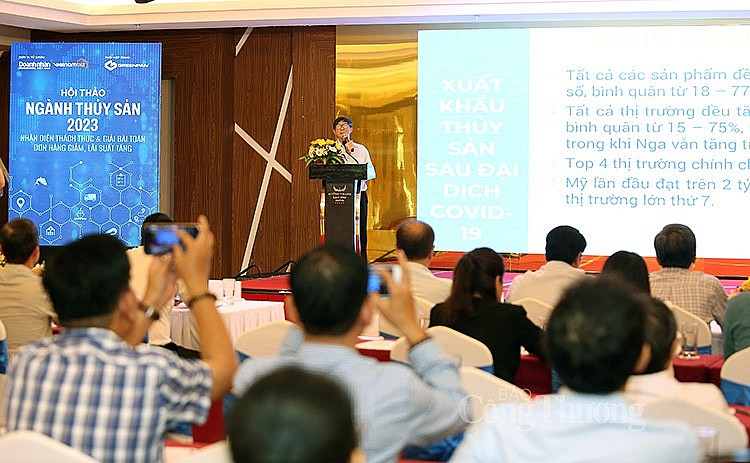 News
News
On the afternoon of November 26, the seminar "Fisheries industry 2023: Identifying challenges and solving the problem of decreasing orders, increasing interest rates". The event was organized by Vietnam Entrepreneurs Electronic Magazine, VietnamBiz General Information Page (vietnambiz.vn) in collaboration with Greenpan Vietnam.
Exports in 2022 are expected to reach 11 billion USD
Mr. Truong Dinh Hoe - General Secretary of Vietnam Association of Seafood Exporters and Producers - said that in 2022, seafood export turnover is estimated to reach about 11 billion USD. In which, shrimp exports reached 4.3 billion USD; pangasius reached 2.5 billion USD; seafood reached 3.2 billion USD; tuna 1 billion USD.
 |
| Mr. Truong Dinh Hoe - General Secretary of Vietnam Association of Seafood Exporters and Producers spoke at the Workshop |
Notably, all products have a double-digit growth, average 18-77%; All markets grew by double digits, averaging 15-75%, except for the UK market , which only increased by 3%, while the Russian market still grew by 0.2%.
TOP 4 main markets accounted for 74%. In which, the United States reached over 2 billion USD for the first time and the UK became the 7th largest market. The results were achieved thanks to the initiative of enterprises in raw materials and production; flexibility and persistence with consumer trends; step up equipment and digital transformation and move towards green production, high social responsibility right in the first 6 months of 2022.
Truong Dinh Hoe said that currently, Vietnam's seafood export ranks third in the world, after China ($18 billion) and Norway ($11 billion), accounting for 7% of the market share. In particular, shrimp exports are in the TOP 4 in the world along with Ecuador, India and Indonesia. With nearly 8% market share in the US and China in 2022 and seafood exports are gradually increasing their market share in the EU after 2 years of EVFTA despite Covid-19.
Identifying challenges for the seafood industry 2023
In addition to the results achieved, at the seminar, experts and businesses said that, after a strong increase in the first half of the year, the export value and orders of seafood enterprises have been increasing. decreasing trend despite entering the peak consumption period at the end of the year.
Under the impact of high global inflation, the exchange rate difference makes exports from Vietnam more expensive than competitors in major import markets such as Europe, the US... decreased, inventory increased, while preservation and logistics are still the weak points of most businesses in the industry.
Meanwhile, with the specificity of having to mobilize a lot of loans to finance the source of goods, many businesses are facing many difficulties during the tight credit period; The sharp increase in interest rates greatly affects business plans and capital costs of enterprises.
 |
Survey results on 117 seafood enterprises through direct and online forms show that up to 71% of enterprises think that the prospect of the seafood industry in 2023 will be difficult, more than 22% of enterprises assess will be very difficult and only about 7% of enterprises are optimistic about the picture of the seafood industry in the coming time.
Three reasons why businesses are concerned in production and business activities from now to 2023 include: exchange rate fluctuations, tight capital sources; World economic recession, rising inflation reduces demand, leading to increased inventories and stiffer competition from low-cost and low-priced competitors such as Ecuador or India.
With the question "What solutions are businesses implementing to cut costs and increase operational efficiency?", most chose to apply modern technology, save energy and effectively manage inventory. warehouse.
At the same time, up to 87% of enterprises are aware of the problem of investing in technology for sustainable development, however, these enterprises said that they have not been able to arrange finance so they cannot deploy and only 13% of them ready investment resources immediately.
At the Workshop, experts, managers and businesses discussed in detail on issues such as: seafood export prospects in 2023, looking for opportunities in new markets; macro variables affecting seafood enterprises 2023 with solutions for capital sources for seafood enterprises; logistics solutions, inventory management.
Mr. Truong Dinh Hoe said that the seafood industry is facing internal challenges such as: infrastructure problems for farming; quality of breeding stock, parental breed; input cost; fisheries management in accordance with the IUU Regulation; fuel costs for fishing; exploitation and assessment of resources. In parallel, there are external challenges such as: inflation , growth slowdown in key markets affecting spending and limiting consumer demand; difficult competition with countries supplying aquatic products with better farming conditions; The Chinese market has great potential, but besides many opportunities, there are also risks due to the diversity in trade as well as Covid-19 management policies.
Despite being assessed for strong growth in 2022, however, according to Dr. Dinh The Hien - economist, market difficulties in the fourth quarter of 2022 and 2023 are exchange rate problems in major markets (except for the market in the fourth quarter of 2022 and 2023). United States) is falling, making export prices likely to be high in these markets.
Challenges that businesses need to overcome include: price competition with regional countries; high shipping costs; IUU 'yellow card' and 'red card' for seafood; The problem of deep processing requires innovation in production technology and a stable source of raw materials. These challenges require large capital for investment in business and production systems, and equipment technology innovation. However, commercial banks are difficult to meet.
The picture of the seafood industry in 2023 is not completely 'gray'. According to Dr. Dinh The Hien, it is expected that by 2023, the cooling down of commercial bank credit capital in real estate will be redirected to production and business companies to meet the current working capital. This will also be an opportunity for seafood enterprises to access capital to expand production and business.
Giving recommendations for businesses in this industry to reduce pressure on capital sources, Dr. Dinh The Hien said that businesses need to build a value supply chain that will reduce the capital needs of companies. Besides, the public joint stock company model will help mobilize capital smoothly. Standardization of business activities according to standards and financial transparency will allow access to capital with good interest rate (7%) from foreign banks in Vietnam….
From an export perspective, Mr. Truong Dinh Hoe said that the Chinese market will reopen. Vietnamese seafood has had a market share in major importing localities such as Shandong, Guangdong, Shanghai, Liaoning, Fujian, Beijing and Tianjin. These localities currently account for 87% of imports. "In the 10 months of 2022, despite the application of the 'Zero Covid' policy, China still imported over 15 billion USD of seafood, higher than the whole year of 2019" , quoted Mr. Truong Dinh Hoe.
On the other hand, Vietnam's seafood industry with the advantage of diversity in aquaculture in line with the trend of green economic development in the world will help seafood exports increase market share in developed countries. Actual processing capacity is 3 million tons/year compared to the current export level of approximately 2 million tons. Vietnam is considered as one of the countries with the most modern seafood processing technology. More than 700 processing facilities are certified by the EU and China. The United States Department of Agriculture (USDA) recognizes the equivalence for the pangasius export industry. The number of businesses with international sustainability certification is increasing. These factors will create support for Vietnamese seafood in 2023.